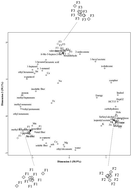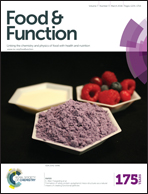Bioactivity, proximate, mineral and volatile profiles along the flowering stages of Opuntia microdasys (Lehm.): defining potential applications
Abstract
Opuntia spp. flowers have been traditionally used for medical purposes, mostly because of their diversity in bioactive molecules with health promoting properties. The proximate, mineral and volatile compound profiles, together with the cytotoxic and antimicrobial properties were characterized in O. microdasys flowers at different maturity stages, revealing several statistically significant differences. O. microdasys stood out mainly for its high contents of dietary fiber, potassium and camphor, and its high activities against HCT15 cells, Staphylococcus aureus, Aspergillus versicolor and Penicillium funiculosum. The vegetative stage showed the highest cytotoxic and antifungal activities, whilst the full flowering stage was particularly active against bacterial species. The complete dataset has been classified by principal component analysis, achieving clearly identifiable groups for each flowering stage, elucidating also the most distinctive features, and comprehensively profiling each of the assayed stages. The results might be useful to define the best flowering stage considering practical application purposes.


 Please wait while we load your content...
Please wait while we load your content...